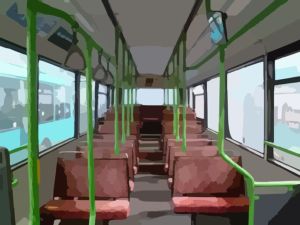Public transportation can be a significant source of anxiety for many individuals, particularly those who suffer from various forms of mental health disorders. The thought of being surrounded by strangers in an unfamiliar environment while traveling at high speeds can trigger feelings of panic and discomfort.
Despite the challenges that come with public transport anxiety, it is possible to overcome them with the right strategies and tools.
By learning how to manage your emotions effectively, developing coping mechanisms, and adopting positive thinking patterns, you can learn to beat public transport anxiety and enjoy safe and comfortable travels.
In this article, we will explore some practical tips on how to overcome public transport anxiety so that you can confidently navigate through any journey without feeling overwhelmed or anxious.
Understanding Public Transport Anxiety
 Imagine stepping onto a crowded train during rush hour. The smell of sweat fills the air, and you’re pressed up against strangers on all sides. Your heart starts racing, your palms begin to sweat, and suddenly it feels like everyone is staring at you.
Imagine stepping onto a crowded train during rush hour. The smell of sweat fills the air, and you’re pressed up against strangers on all sides. Your heart starts racing, your palms begin to sweat, and suddenly it feels like everyone is staring at you.
This overwhelming feeling of anxiety can be experienced by anyone who suffers from public transport anxiety. Cognitive behavioral therapy (CBT) is an effective treatment for managing this type of anxiety disorder. CBT involves identifying negative thought patterns and replacing them with more positive ones.
Exposure therapy, which is a form of CBT, helps individuals gradually face their fears in a safe environment until they become desensitized to triggering situations. Public transport anxiety can manifest itself in many ways including panic attacks, sweaty palms, increased heart rate or difficulty breathing.
Recognizing triggers and symptoms is crucial in overcoming this condition. By understanding the root causes of public transport anxiety through cognitive behavioral therapy and exposure therapy techniques, individuals can take steps towards recognizing potential triggers and symptoms that lead to their anxiety. Such knowledge empowers people to confront these issues head-on rather than avoiding situations altogether.
Recognizing Triggers And Symptoms
Identifying triggers and common symptoms is an important step in managing public transport anxiety. One of the most effective ways to identify triggers is by paying attention to what causes the anxiety, such as crowded spaces or a fear of being trapped. Additionally, recognizing how your body reacts can help pinpoint specific triggers.
Common physical symptoms include sweating, trembling, shortness of breath, and nausea. It’s also helpful to understand that anxiety doesn’t always manifest itself physically. Emotional symptoms like feelings of dread, panic attacks, and irritability are just as valid indicators of public transport anxiety.
Avoiding situations that trigger these emotions may seem like a good solution but ultimately reinforces the negative cycle associated with this phobia. Cognitive-behavioral therapy (CBT) is often used to treat public transport anxiety by helping individuals develop coping mechanisms for both emotional and physical symptoms.
This type of therapy involves identifying harmful thought patterns and replacing them with more positive ones. Relaxation techniques like deep breathing exercises or meditation can also be beneficial when experiencing physical symptoms. In addition to CBT, developing coping mechanisms for public transport anxiety may involve gradual exposure therapy where individuals gradually expose themselves to their fears until they feel comfortable enough to handle it without significant distress.
Learning relaxation techniques and practicing mindfulness can also be useful in preventing future episodes of public transport anxiety.
Developing Coping Mechanisms
Recognizing triggers and symptoms of public transport anxiety can help individuals develop coping mechanisms to alleviate their distressing experiences. However, developing these coping mechanisms is not always an easy task, as it requires a lot of effort and commitment.
It may seem ironic that the solution to overcoming public transport anxiety involves exposing oneself more frequently to the trigger itself. Nevertheless, with proper guidance, support, and practice, one can learn various relaxation techniques like breathing exercises and mindfulness practices.
Breathing exercises are simple yet effective ways to reduce physical sensations associated with anxiety such as rapid heartbeat or shortness of breath. Practicing deep breathing for just a few minutes each day can have significant long-term benefits in reducing overall levels of stress and anxiety.
Another way to cope with public transport-related fears is by practicing mindfulness meditation techniques. Mindfulness helps people stay present in the moment without being overwhelmed by thoughts or emotions related to past or future events.
Incorporating relaxation techniques into daily routines takes time and patience. Individuals must be willing to commit themselves fully to the process if they want to see positive results over time. The key is finding what works best for them individually; there isn’t a single right answer when it comes down to combating public transportation anxieties through relaxation techniques.
Practicing relaxation techniques regularly can significantly improve one’s ability to manage anxious feelings during transit journeys eventually. These strategies should be integrated into everyday life so that they become automatic responses rather than something that has been forced upon someone struggling with anxiety symptoms.
Ultimately, utilizing these tools will provide much-needed relief from debilitating fear and allow individuals greater freedom in navigating their world without feeling trapped by their own minds’ limitations.
Practicing Relaxation Techniques
Practicing relaxation techniques can help individuals manage their public transport anxiety.
Breathing exercises are a simple and effective technique that can be done anywhere, anytime. This involves taking slow, deep breaths in through the nose and out through the mouth, focusing on each inhalation and exhalation.
Mindfulness practices also help to reduce anxiety by bringing attention to the present moment rather than worrying about potential future scenarios.
Progressive muscle relaxation is another useful technique for combating public transport anxiety. This entails tensing individual muscles groups while inhaling and relaxing them while exhaling, starting from the toes working up to the head. By doing so, this helps individuals become more aware of physical sensations in their body and allows them to release any tension held within it.
Visualization techniques involve imagining positive experiences during transportation or creating mental images of calming environments such as nature scenes or peaceful settings. These methods have been proven effective in reducing stress levels, lowering blood pressure, and promoting overall well-being.
Incorporating these relaxation techniques into daily routines can significantly improve one’s ability to cope with public transport anxiety.
While learning new skills may take time and practice, consistent effort will lead to mastery over time.
In addition to practicing these techniques regularly, adopting positive thinking patterns can further enhance results by changing negative thought processes related to travel into more constructive ones focused on successful outcomes.
Adopting Positive Thinking Patterns
After practicing relaxation techniques, you may find yourself feeling calmer and more in control of your thoughts and emotions. However, it is important to acknowledge that anxiety can still arise when faced with the prospect of using public transport.
The key to overcoming this fear lies in cognitive restructuring. Cognitive restructuring involves identifying negative thought patterns and replacing them with positive ones. This technique can help you challenge any irrational beliefs or fears you have about public transport.
For example, instead of thinking ‘I’m going to get lost on the bus’, try reframing it as ‘I have a map and can ask for directions if needed’. By changing your perspective, you are less likely to feel overwhelmed or anxious. Another effective strategy is mindfulness practices.
Mindfulness involves being present in the moment and observing your thoughts without judgment. When riding public transport, focus on your breathing or notice the scenery around you. Engaging in these types of activities can help distract from anxious thoughts and promote a sense of calmness.
If you find that despite trying these techniques, your anxiety persists, seeking professional help may be necessary. A mental health therapist can work with you to develop personalized strategies for coping with public transport anxiety. They may also explore underlying causes of your anxiety and provide additional tools for managing symptoms.
While learning new skills like cognitive restructuring and mindfulness takes time and effort, remember that seeking professional help is always an option if needed.
Seeking Professional Help
Overcoming public transport anxiety can be a challenging experience. Despite the wide prevalence of this condition, many people feel ashamed to seek help due to stigmatization surrounding mental health. However, it is important to recognize that seeking professional help is an essential step towards overcoming this debilitating problem.
Finding a therapist who specializes in anxiety disorders can provide individuals with tools and strategies for managing their symptoms. During therapy sessions, clients will learn how to identify triggers, manage negative thoughts and emotions, and develop coping mechanisms to deal with stressors associated with public transportation. Additionally, therapists can assist in developing exposure therapy plans which involve gradually exposing clients to stimuli that trigger anxiety responses while teaching them adaptive ways of responding.
It is normal for people suffering from public transport anxiety to find themselves feeling isolated or hopeless. Seeking professional help provides not only emotional support but also reassurance that one is on the right path towards recovery.
It’s easier said than done, but finding a suitable therapist requires some effort – do research online, ask friends or family members for recommendations or reach out to professional associations such as the American Psychological Association (APA) for resources.
Overcoming stigma around mental health concerns like public transport anxiety should never stop anyone from accessing treatment options available today. Finding a qualified therapist who understands your unique needs and personal history may take time; however, once you have established yourself under their care and guidance, you will gain invaluable skills necessary for enjoying safe and comfortable travels without fear of panic attacks or other adverse reactions associated with your phobia.
Enjoying Safe And Comfortable Travels
How can one enjoy safe and comfortable travels despite having public transport anxiety? It’s a common question that many individuals ask themselves when planning to embark on journeys via public transportation. The good news is there are ways to manage this fear and make the experience more enjoyable.
Firstly, tips for navigating unfamiliar routes can be helpful. Familiarizing oneself with the route beforehand can help reduce anxiety levels. Using online maps, talking to locals or using navigation apps are excellent resources to obtain information about unfamiliar locations. Additionally, arriving at stations earlier than expected allows extra time to get oriented with the surroundings and mentally prepare for the journey ahead.
Secondly, finding comfort in routine journeys provides peace of mind. Creating a routine by taking familiar routes repeatedly can help combat public transport anxieties. This helps establish predictability and eliminates surprises that may trigger anxious thoughts while traveling.
Lastly, it’s crucial to take care of oneself during travel times. Engage in calming activities like reading books or listening to music before boarding any means of transportation. These activities help distract from anxious thoughts and promote relaxation during transit periods.
Managing public transport anxiety requires patience and practice; however, incorporating these simple steps into your daily life will gradually alleviate fears associated with such travels over time.
Remember always to prioritize self-care practices while traveling as they play an essential role in creating a peaceful mindset conducive to safe and comfortable travels without apprehension.
Frequently Asked Questions
How Do I Deal With My Fear Of Getting Lost While Using Public Transport?
When navigating public transport, it is common to experience fear of getting lost.
Preparation tips can help alleviate this anxiety by familiarizing oneself with the route and schedule prior to traveling.
Navigation techniques such as using GPS or maps provided by the transit system can also ease apprehension about going off course.
Additionally, taking deep breaths and practicing relaxation techniques while on board can aid in managing any remaining feelings of unease.
It is important to remember that feeling anxious is a normal response when faced with new situations, but utilizing these strategies can improve confidence and make for a smoother journey overall.
What Should I Do If I Have A Panic Attack While Using Public Transport?
If an individual experiences a panic attack while using public transport, it can be overwhelming and debilitating.
Breathing exercises can help alleviate some of the physical symptoms associated with panic attacks, such as shortness of breath and rapid heartbeat.
It is recommended to practice deep breathing techniques regularly in advance so that they become familiar during moments of anxiety.
Seeking professional help from a mental health therapist may also be beneficial for developing coping strategies and addressing underlying anxiety disorders.
Cognitive-behavioral therapy (CBT) has been shown to effectively treat anxiety disorders by identifying negative thinking patterns and replacing them with positive ones.
In severe cases, medication may also be prescribed by a healthcare provider.
How Can I Overcome My Fear Of Being In Crowded Spaces On Public Transport?
Individuals who experience fear of being in crowded spaces on public transport could benefit from utilizing various techniques to help manage their anxiety.
Two such techniques include deep breathing and visualization exercises, which can assist individuals in calming their minds and reducing physical symptoms associated with anxiety.
In addition, positive self-talk and exposure therapy may be helpful for gradually desensitizing oneself to the feared situation.
A mental health therapist can guide individuals through these techniques while also providing support and encouragement throughout the process.
It is important to note that overcoming a fear of public transportation may require patience, persistence, and consistent practice of these strategies.
What Should I Do If I Encounter A Difficult Or Confrontational Passenger While Using Public Transport?
Encountering a difficult or confrontational passenger while using public transport can be a distressing experience. However, it is important to stay calm and composed in such situations.
Using de-escalation techniques like active listening, empathizing with the other person’s perspective, and offering possible solutions can help diffuse the situation. It may also be helpful to undergo assertiveness training to learn how to communicate confidently and effectively without being aggressive or passive.
As a mental health therapist, I recommend seeking professional support if these encounters cause significant distress or anxiety.
How Do I Manage My Anxiety About Being Late Or Missing A Connection While Using Public Transport?
To manage anxiety around being late or missing a connection while using public transport, it can be helpful to prioritize time management strategies such as arriving early and planning ahead for potential delays.
Relaxation techniques like deep breathing, progressive muscle relaxation, and visualization exercises may also assist in reducing feelings of stress and tension.
Navigation tips such as familiarizing oneself with the transportation schedule and route beforehand can help ease concerns about getting lost or confused during travel.
Additionally, developing effective communication skills by confidently asking for assistance or clarifying information when needed can reduce uncertainty and increase confidence in navigating public transportation.
As a mental health therapist, I would recommend incorporating these practices into one’s daily routine to better cope with anxieties related to public transit.
Conclusion
For individuals with public transport anxiety, it is important to recognize that fear and panic can be managed.
When dealing with the fear of getting lost, research routes in advance, use maps and apps for guidance, and ask for help if needed. In case of a panic attack during travel, use grounding techniques such as deep breathing or visualization exercises. Moreover, communication with loved ones about your plans can provide support.
Crowded spaces on public transport are another common trigger for anxiety. To overcome this fear, try traveling outside peak hours or finding alternative transportation methods. If encountering a difficult passenger, remember that their behavior is not your fault and seek assistance from authorities or other passengers.
Lastly, managing time-related stress involves planning ahead and having contingency plans.
In conclusion, public transport anxiety can be challenging but manageable through coping strategies such as preparation, self-care practices and seeking external support when necessary. As mental health therapists often say ‘The journey towards healing starts by acknowledging one’s emotions.’ By being aware of our fears we can take proactive measures to regain control over them while travelling on public transport.





